Nature Notes or Nature’s Oddities #1
Rick Hollis
Introduction
This part of our blog will be irregular, occurring after I find something that makes me curious. Either things I see on my own or things I find on the web.
If you see something curious in nature and want to know more about it, let me know I and I will try to find out what it is.
All photos are used with permission.
If you find something puzzling, send me a picture and I will try to find out what it is.
Insect Camouflage
Most of the time when I think of animal camouflage I think of cryptic coloration that hides the animal. Here are two examples of insect larvae that deliberately camouflage themselves with debris.
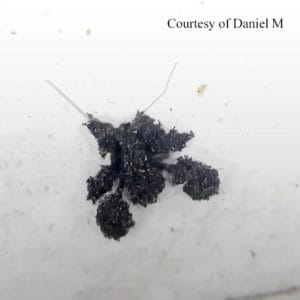
Masked Hunter
Reduvius personatus
This image comes to us from Daniel M by way of Andy McCollum up at Cornell College. You have to admit it is one of the strangest looking critters out there. It is a Masked Hunter, Reduvius personatus, nymph of . Nymphs of this species disguise themselves with bits of debris. They even chose the debris used to make them even harder to use. If you go to bugnet your will find a variety of patterns for this species. Linnaeus new of this critters habits when he gave it the species name personatus which translated to ‘disguised’. Daniel took this photo in Madison County, central New York, in August 9th, 2013.
Another set of photos come to us via Matt Kenne. These tiny ball-shaped piles of stuff were taken in Call SP in Kossuth Co, in late August. Matt was beating Bur Oaks to collect caterpillars and this fell on to his sheet. This is a Green Lacewing Larva.
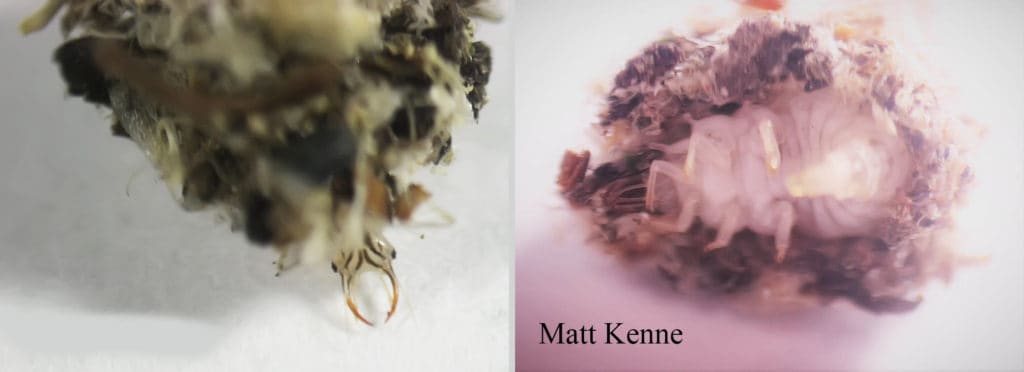
Green Lacewing Larva
Mantling
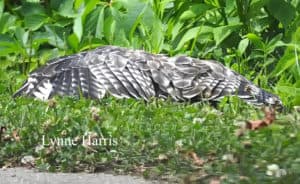
Red-shouldered Hawk
Manting prey
Lynne Harris from Indiana Nature & Wildlife Photographers took this photo near Logansport IN of a Red-shouldered Hawk Mantling a prey item. Mantling is described as ‘hunching or arching shoulders and spreading wings over a recent kill’. It is typically seen in larger raptors1 and is especially typical in open country2. It is thought to conceal the prey from someone else who might wan to steal your prey and eat it themselves. Mantling is also supposedly known as Covering or Shrouding.to steal it.
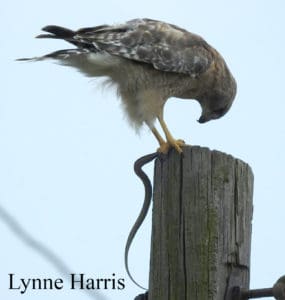
Red-shouldered Hawk
after mantling its prey it flew to this pole.
+ others can see better
1 larger birds have lower success rates in hunting so each prey item is more ‘valuable’
2 Greater visibility in open country mean more other birds have the potential to see your meal.
After shielding the prey item on the ground, the hawk few up to a telephone pole a consumed the Garter Snake.
Spider Sex
Sex for spiders is not easy. The male is often considerably smaller than the female, which makes him a possible meal. When I looked at this pair of spiders I found on the same web, I assumed the big one was the female and the small was the male. He was only about ¼ or ⅓ of her size. When I looked the male carefully I saw what looked liked boxing gloves on the male. The boxing gloves are Spermathecae — bulbs used to inactive hold Spider Sperm. The male stores the sperm, when the female is ready to mate the male quickly inserts the packaged sperm and tries to get away before she notices him.
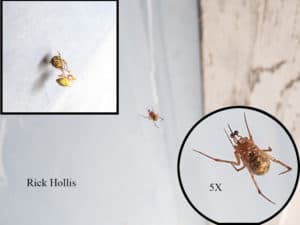
Boxing Gloves on Male spider
Inserts:
The male is magnified 5x.
The female is not magnified.
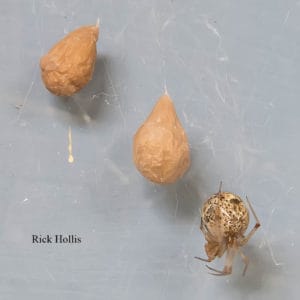
Some time after successful transfer of the sperm, the female laid eggs in these nests.
Wetland Blog
Paul Waite, an Associate Professor in Biology at Coe, is planning on visiting one wetland in all of Iowa’s Counties. His Blog is http://99wetlands.wordpress.com/
A recent post is on the Iowa River Landing Wetland Park.
https://99wetlands.wordpress.com/2017/08/30/former-wasteland-now-a-fancy-wetland/
 This is a place that has been on my list of places to visit. Maybe this will prod me to do this.”
This is a place that has been on my list of places to visit. Maybe this will prod me to do this.”
‘Cigarrettes’
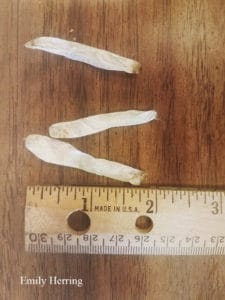
Linings from the burrows of the burrowing webworm‘Cigarettes’
This comes to us from Emily Herring, the Naturalist from Marshall County Conservation. There are the silk, burrow linings of the burrowing webworm. See the email below.
The caterpillar lives in a burrow which it lines with silk like material. Later, birds pull the silk linings from the ground to either eat the caterpillar or check for food. Because of they resemble to cigarettes on the ground, the alternate name is cigarette paper webworm.
Here is an article. https://www.extension.iastate.edu/turfgrass/blog/nick-christians/cigarette-paper-webworm
